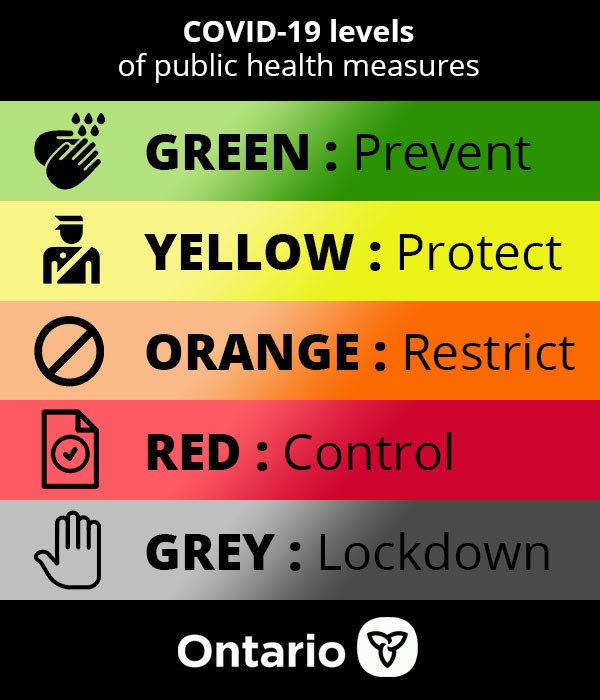The Ontario government announced a new COVID-19 response framework, which allows the province to rank health units based on case numbers and trends, using colour-coded categories.
Each week, the health units will be reassessed and placed into a category. According to Ontario Premier Doug Ford, this will serve as an “early warning system”.
“Everyone has a role to play. We need to continue to fight. Please don’t lose hope,” said Ford. “Never has so much depended on us coming together as a people, a province. Together we can, and we will get through this.”
Here is what to expect from the colour-coded levels:
Green (Prevent)
What it is: The “green” level, also known as the “prevent” level, will put a health unit into a state similar to the former Stage 3, with loosened restrictions and only certain high-risk locations remaining closed.
Proposed restrictions for this level include: A two-metre distance between tables at dining establishments, nightclubs operating as restaurants or bars. This also means a maximum of 50 people inside gyms or fitness centres, limiting fitting room capacity at retail stores and the closing of oxygen bars, steam rooms, saunas and whirlpools in personal-care facilities. Capacity would also be limited to 50 people at gaming establishments.
How to get there: Health Units at this level will have a weekly rate of less than 10 cases per 100,000 people and a positivity rate of less than one per cent.
As of Nov. 18, Algoma Public Health, North Bay Parry Sound District, Northwestern Health Unit, Porcupine Health Unit, Thunder Bay District Health Unit, and Timiskaming Health Unit are at this level.
Yellow (Protect)
What it is: The “yellow” or “protect” level means health units will see increased measures and guidelines for businesses or organizations that are open.
Proposed restrictions for this level include: Events and social gatherings will be limited to 10 people indoors and 25 people outdoors. Organized public events and gatherings will be limited to 50 people indoors and 100 people outdoors. Liquor sold or served only between 9 a.m. to 11 p.m.
No consumption of liquor permitted between 12 a.m. to 9 a.m. Required face coverings at sports and recreation facilities (except when exercising), limited volume of music at retail locations and required contact information from customers at some establishments.
How to get there: The Health Units at this level are required to have a weekly rate of 10 to 39.9 cases per 100,000 people and a positivity rate of one to 2.5 per cent.
Public Health Sudbury and Districts moved into this stage Nov. 16.
Orange (Restrict)
What it is: Health Units at the “orange” or “restrict” level will see restrictions enhanced further from the “protect” level.
Proposed restrictions for this level include: Limiting capacity at meeting and event spaces to 50 people per facility, limiting operating hours for businesses, enhancing screening measures at various businesses and establishments, prohibiting personal care services that require the removal of a face mask and limiting capacity in retail locations. Liquor may only be sold or served between 9 a.m. and 9 p.m. Liquor cannot be consumed between 10 p.m. and 9 a.m.
How to get there: These Health Units will have a weekly incidence rate of 40 to 99.9 per 100,000 people and a positivity rate ranging from 2.5 to 9.9 per cent.
Red (Control)
What it is: The “red” or “control” level means a return to modified Stage 2, with further restrictions and the closure of some businesses or organizations.
Proposed restrictions for this level include: Prohibiting indoor dining, closing gyms and indoor fitness centres, cinemas, casinos, bingo halls and other gaming establishments, limiting capacity at indoor event spaces to 10 people per facility. All those living in a red zone should only leave home for essentials.
How to get there: The Health Units at this level will have a weekly incidence rate of more than 100 cases per 100,000 people and a positivity rate of more than 10 per cent.
Grey (Lockdown)
At this level, Health Units would return to a modified Stage 1, and a declaration of emergency will be considered.
A full breakdown can be found here.
Bird Bouchard is a Local Journalism Initiative (LJI) reporter with the Ridgetown Independent News. The LJI program is funded by the Government of Canada.
This story was updated from its original version to include Northern Ontario health units.



